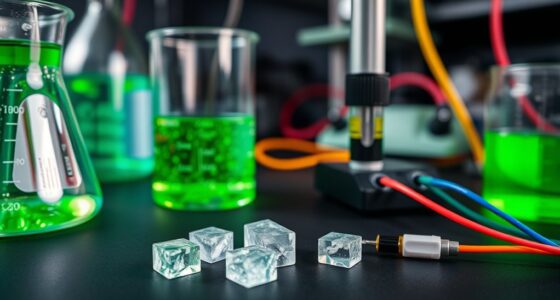Your choice of anode and cathode materials directly impacts your battery’s performance, durability, and safety. Graphite anodes are popular for their stability and ease of manufacturing, while silicon can boost capacity but requires advanced fabrication techniques. On the cathode side, lithium cobalt oxide is common but faces resource concerns, whereas lithium-rich compounds offer higher energy density. Making informed material selections balances performance and manufacturing challenges, helping you optimize the battery’s lifespan — explore further to see how these choices shape your device’s capabilities.
Key Takeaways
- Anode and cathode materials determine overall battery energy density, capacity, and voltage performance.
- Material stability and reactivity influence electrode lifespan and safety during charge cycles.
- Manufacturing complexity varies: graphite anodes are easier to produce than silicon-based anodes; cathode choices affect scalability.
- Trade-offs exist between high energy density (e.g., silicon, lithium-rich cathodes) and manufacturing challenges or durability.
- Advanced material innovations and coatings improve electrode performance and address manufacturing and longevity concerns.

Understanding the difference between anode and cathode is essential when studying how batteries and electronic devices work. These two electrodes are fundamental to electrochemical processes, and their material choices directly impact device performance, longevity, and safety. When selecting materials for anodes and cathodes, you need to consider electrode durability, as it determines how well the electrode withstands repeated charging and discharging cycles. A durable electrode maintains its structural integrity over time, ensuring consistent energy output and reducing the risk of failure. If an electrode degrades quickly, it can lead to capacity loss, increased internal resistance, and potential safety hazards. Because electrode durability varies with material composition, manufacturers often face trade-offs between high energy density and longevity, making material selection a critical part of battery design. Additionally, manufacturing challenges such as achieving uniform coatings and controlling material reactivity can significantly influence the overall quality and performance of the electrodes. Manufacturing challenges also play a significant role in the choice of electrode materials. Producing high-quality anodes and cathodes involves complex processes that require precision and consistency. For instance, creating thin, uniform layers of active materials on current collectors can be difficult, especially when scaling up production. Variations in material quality can lead to defects, reduced electrode lifespan, and inconsistent performance across batches. Furthermore, some advanced electrode materials, like silicon for anodes or certain lithium-rich compounds for cathodes, pose specific manufacturing hurdles due to their reactivity or difficulty in forming stable interfaces. These challenges drive up production costs and can limit the widespread adoption of innovative materials, despite their potential performance benefits. Another aspect to consider is how the material choices for anodes and cathodes influence manufacturing challenges. For example, while graphite remains the standard for anodes due to its stability and ease of manufacturing, alternative materials like silicon offer higher capacity but demand more sophisticated fabrication techniques. Similarly, cathode materials such as lithium cobalt oxide are well-understood and easier to produce at scale, but they face issues like resource scarcity and environmental concerns. This means that optimizing electrode durability often involves balancing material properties with manufacturability. As you explore battery designs, you’ll find that overcoming manufacturing challenges frequently requires innovative engineering solutions, such as developing composite materials or advanced coating techniques, to improve electrode stability without sacrificing performance.
Frequently Asked Questions
How Do Material Costs Influence Anode and Cathode Selection?
You need to contemplate how material costs impact your choice of anode and cathode, as they directly affect overall battery expenses. Higher-cost materials can lead to significant cost implications, especially if supply chain issues cause shortages or price fluctuations. By selecting more affordable, readily available materials, you can optimize production costs while maintaining performance. Balancing material costs with supply chain stability is key to developing efficient, cost-effective batteries.
What Are the Environmental Impacts of Different Anode and Cathode Materials?
You should consider the environmental impacts of anode and cathode materials. Eco-friendly alternatives reduce pollution and energy use, making devices safer for the planet. However, toxicity concerns arise with materials like cobalt and nickel, which can harm ecosystems during mining and disposal. Choosing sustainable options helps minimize these impacts, ensuring your technology supports environmental health while maintaining performance.
How Do Temperature Variations Affect Anode and Cathode Performance?
Think of your battery as a busy highway—temperature variations can cause traffic jams or smooth sailing. When temperatures rise or fall, your anode and cathode experience changes in thermal stability and conductivity variations. High heat can reduce efficiency and accelerate degradation, while cold temperatures slow reactions. You need to monitor and manage these fluctuations, ensuring your battery maintains ideal performance and longevity, no matter the weather outside.
Are There Innovative Materials Replacing Traditional Anode and Cathode Options?
You might be curious if innovative materials are replacing traditional options. Solid-state batteries use solid electrolytes, offering better safety and energy density. Metal oxide materials are also gaining attention for their stability and high capacity. These advancements could lead to longer-lasting, more efficient batteries, transforming energy storage. As technology evolves, expect to see more solid-state and metal oxide innovations that improve performance and safety compared to conventional materials.
How Does Electrode Material Choice Impact Battery Recycling Processes?
Choosing electrode materials directly impacts your battery recycling process by influencing recycling efficiency and material recovery. If you select materials that are easier to separate and process, you’ll find recycling more effective and environmentally friendly. Sustainable materials can reduce hazardous waste and improve the recovery of valuable metals. Your material choices can streamline the recycling cycle, making it more cost-efficient and less resource-intensive, ultimately supporting a greener, more sustainable battery lifecycle.
Conclusion
Ultimately, choosing the right materials for your anode and cathode can substantially impact your device’s performance. It’s often believed that optimizing these materials boosts efficiency and longevity, and studies confirm this. When you select compatible, high-quality materials, you’re not just improving performance—you’re validating the theory that material choices directly influence energy storage and transfer. So, don’t underestimate the power of these components; your careful selection makes all the difference in achieving reliable, long-lasting results.










